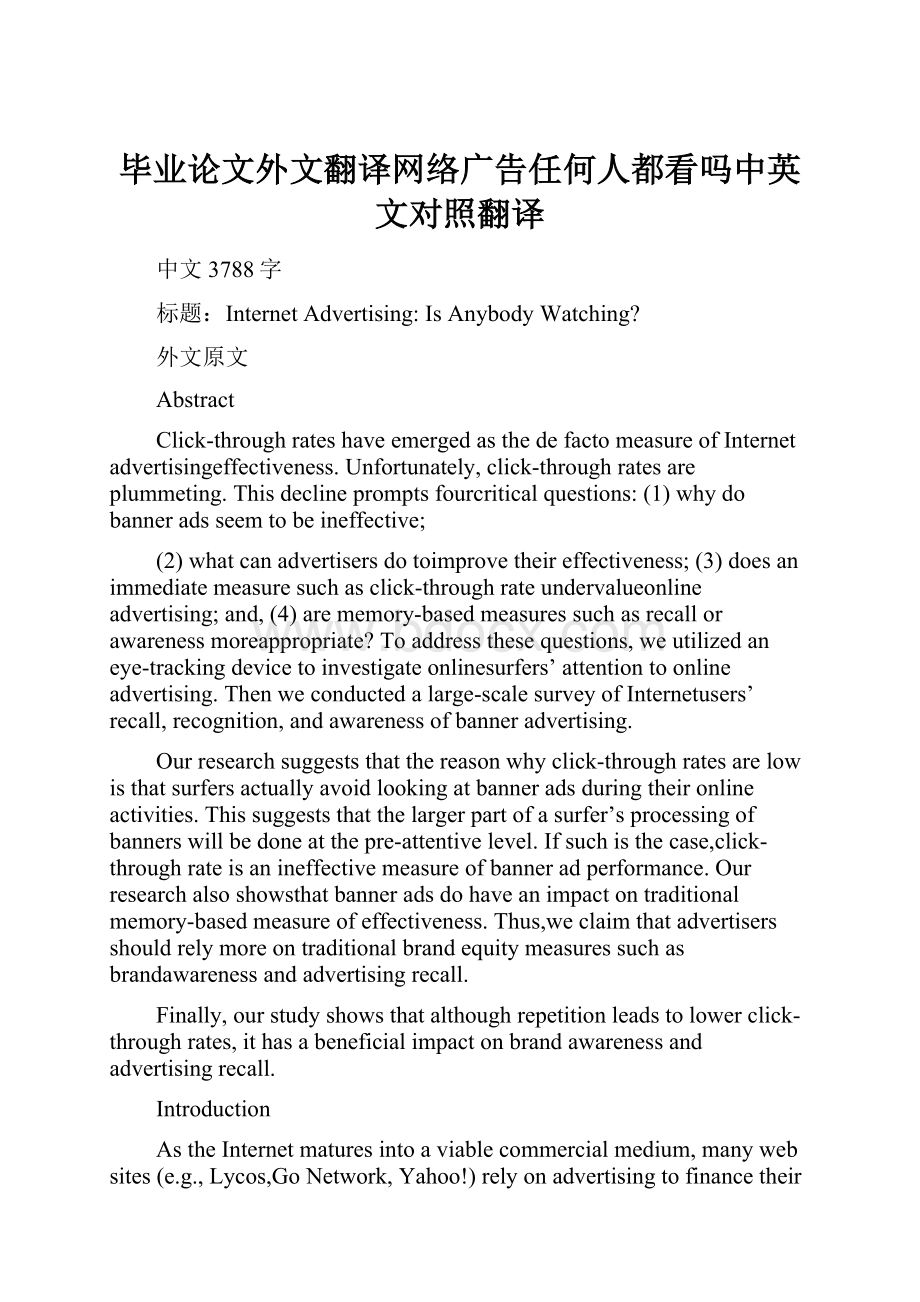毕业论文外文翻译网络广告任何人都看吗中英文对照翻译.docx
《毕业论文外文翻译网络广告任何人都看吗中英文对照翻译.docx》由会员分享,可在线阅读,更多相关《毕业论文外文翻译网络广告任何人都看吗中英文对照翻译.docx(11页珍藏版)》请在冰豆网上搜索。

毕业论文外文翻译网络广告任何人都看吗中英文对照翻译
中文3788字
标题:
InternetAdvertising:
IsAnybodyWatching?
外文原文
Abstract
Click-throughrateshaveemergedasthedefactomeasureofInternetadvertisingeffectiveness.Unfortunately,click-throughratesareplummeting.Thisdeclinepromptsfourcriticalquestions:
(1)whydobanneradsseemtobeineffective;
(2)whatcanadvertisersdotoimprovetheireffectiveness;(3)doesanimmediatemeasuresuchasclick-throughrateundervalueonlineadvertising;and,(4)arememory-basedmeasuressuchasrecallorawarenessmoreappropriate?
Toaddressthesequestions,weutilizedaneye-trackingdevicetoinvestigateonlinesurfers’attentiontoonlineadvertising.Thenweconductedalarge-scalesurveyofInternetusers’recall,recognition,andawarenessofbanneradvertising.
Ourresearchsuggeststhatthereasonwhyclick-throughratesarelowisthatsurfersactuallyavoidlookingatbanneradsduringtheironlineactivities.Thissuggeststhatthelargerpartofasurfer’sprocessingofbannerswillbedoneatthepre-attentivelevel.Ifsuchisthecase,click-throughrateisanineffectivemeasureofbanneradperformance.Ourresearchalsoshowsthatbanneradsdohaveanimpactontraditionalmemory-basedmeasureofeffectiveness.Thus,weclaimthatadvertisersshouldrelymoreontraditionalbrandequitymeasuressuchasbrandawarenessandadvertisingrecall.
Finally,ourstudyshowsthatalthoughrepetitionleadstolowerclick-throughrates,ithasabeneficialimpactonbrandawarenessandadvertisingrecall.
Introduction
AstheInternetmaturesintoaviablecommercialmedium,manywebsites(e.g.,Lycos,GoNetwork,Yahoo!
)relyonadvertisingtofinancetheiroperations.ThelureofadvertisingissuchthatsomecompaniesprovideuserswithfreeInternetaccess(e.g.,NetZ,FreeI.com)andevenfreecomputers(e.g.,Free-PC.com)inexchangefortheireyeballs(Berst1999).Thisshouldnotcomeasasurpriseasadvertisershavelongusedeveryconceivablevehicletodisplaytheirmessagesinfrontofthegazingeyesofpotentialcustomers,beitmagazines,television,orracecars.
AstheInternetbecomesmoremainstream,manycompaniesarebudgetingsignificantdollaramountsforonlineadvertising.TheInternetAdvertisingBureau(1999)reports1998onlineadvertisingexpenditureof$1.92billion,morethandouble1997revenues.Thebulkofthisexpenditureisallocatedtobannerads.Banneradstypicallyconsistofrectangularimagesdisplayedatthetopofwebpagesandcontainthemessagethattheadvertiserwantstosendtowebsurfers.
Themostwidelyusedmeasureofonlineadvertisingeffectivenessisthepercentageofthetotalnumberofadexposuresthatinducethesurfertoactuallyclickonthebannerinresponsetotheadvertisedmessage.Thismeasureisknownastheclick-throughrate(NovakandHoffman1997).Click-throughratehasbecomesuchadominantmeasurethatin1996ProcterandGamblemadeadealwithYahoo!
inwhichP&Gwouldpayonlyforclick-throughsandnotforexposures(AssociatedPress1996).Theabilityofasitetogenerateclick-throughsalsoaffectstheadvertisingratesitcancommand(Hamilton1998).
Click-throughratesstartedin1996ataroundsevenpercent.However,theyhavedeclinedsteadilytoaround0.6%in1999(Nielsen//Netratings1999).Thisisproblematicbecauseadvertiserstypicallydonotknowinglyallocatebudgetstomediathatarenoteffective.Doesthistrendsuggestthattheonlineadvertisingcommunityisgoingtofritteralongwiththedeclineinclick-throughrates?
ShouldonesellhisorherstocksinYahoo!
?
Notnecessarily.Manyauthors(Ambler1998,Batra,Lehmann,Burke,andPae1995)arguethatgoodadvertisingaffectslong-termbrandequity,notnecessarilyshort-termsales.Theycontendthatequityvariablessuchasbrandoradawarenessarebettergaugesofadvertisingeffectiveness.Inthisspirit,BriggsandHollis(1997)haveshownusingMilwardBrown’sBrandDynamics™system(Dyson,Farr,andHollis,1996),thatbanneradscanhaveanimpactonconsumers’attitudestowardabrandindependentofclick-through.
BriggsandHollis’study,combinedwiththedeclineinclick-throughrate,begsthequestions
(1)whydobanneradsseemtobeineffective;
(2)whatcanadvertisersdotoimprovetheireffectiveness;(3)doesanimmediatemeasuresuchasclick-throughrateunder-valueonlineadvertising;and,(4)aremoretraditionalmeasuressuchasrecallorawarenessmoreappropriate?
Thepurposeofthispaperistoanswerthesefourquestions.Weintendtoshowthatbecausebanneradsoperatemostlyatthepre-attentiveprocessinglevel(Shapiro,MacInnis,andHoyer1997),traditionaleffectivenessmeasuresaremoreappropriatethanclick-throughrates.Wewillthenusethesemeasurestostudysomeofthefactorsthatmightimpactbanneradeffectiveness.
Theremainderofthepaperisorganizedasfollows.Thefirstsectiondiscussestheresultsofastudywhichutilizedaneye-trackingdevicetodeterminewhetherwebsurfersseebanneradsandwhichfactorsincreaseordecreasetheprobabilitythatabanneradisseen.Weusetheresultsfromthisfirststudytogeneratehypothesesaboutthecharacteristicsofbanneradsthatmightincreaseordecreaseviewers’attention.Thefollowingsectionrelatestheresultsofthefollow-upstudythattestedthehypothesesgeneratedinthefirststudyonabroadersampleofwebsurfers(807respondents).ThestudyalsoexploredtheeffectsofInternetadvertisingonrecall,recognition,andawareness.Wethenconsidertheresultsofbothstudiesanddiscusstheirmanagerialrelevance.Finally,weclosewithconcludingremarks,adiscussionofthelimitationsofourmethodologyandresults,anddirectionsforfutureresearch.Study1:
Eye-tracking
TheInternetdiffersfromtraditionalmediainatleastonesignificantway.WhenanadvertiserusesTelevisionorRadiotodeliverhismessages,hepreemptstheprogrambeingbroadcast(e.g.,asitcomorsong)andusesallthebandwidthofthemediumtotransmithismessage.Thismeansthatbydefault,theviewerorlistenerispayingattentiontotheadvertisers,andthemessageisonlyinterruptedifthelistenerzapsaway.Zapping,however,isquiteinfrequent.Siddarth(1999)reportszappingratesforcommercialsoflessthan3%.Bycontrast,onlinebanneradssharetheirbandwidthwithotherelementsofthepagesinwhichtheyarebeingdisplayed.Abanneradtypicallyoccupieslessthan10%oftheareaofawebpageonastandardVGAcomputerscreen(640x480pixels).Therefore,theattentionofthewebsurferisgenerallyfocusedonotherelementsofthepage.Thetaskofthebanneradistofirstgrabasurfer’sattentionandsecondtoinducethesurfertoclickonthead.Ifsurfersneverlookatabanner,theycannotclickonit!
Sharedbandwidthmightexplainwhyclick-throughratesarelow,butnotwhytheyaredeclining.Thereissomeevidencethatsomeonlinesurfersdislikebannerads(Bass1999).Thisdislikeiswidespreadenoughthatvarioussoftwareexistthatactuallypreventbrowsersfromdownloadingads(AdsOff!
@Guard,JunkBuster...).Onecanthushypothesizethat,assurfersgainmorefamiliaritywiththemedium,theylearntodifferentiateinformationalcontentfromadvertising.Ultimately,thiswouldgivethemtheabilitytodisregardbannerads.
Giventhispossiblelearningandavoidancebehavior,westartourinvestigationbymeasuringtheextenttowhichsurferspayattentiontobannerads.Webeginbyformulatingthefollowingtwohypotheses:
H1:
Internetusersavoidlookingatbannerads.
H2:
ThemoretimeusershavespentontheInternet,thelesstheypayattentiontobannerads.
Totestthesehypotheses,weaskedagroupofsubjectstolookatvariouswebpageswhilehookeduptoaneye-trackingdevicethatrecordstheireyemovementsandfixations.Eyetrackingstudiesarenotnew.Javal(1878)usedeye-trackingtostudyreadingpatternsmorethan100yearsago.Althoughreadingstudiesarestillbeingconductedthrougheye-tracking(Hyönä1995),agrowingnumberofeye-trackingstudieshaverecentlyaddressedmarketingproblems.Forinstance,RussoandLeclerc(1994)studiedin-storebrandchoice,Fischeretal(1989)studiedwarninglabelsontobaccoads,Janiszewski(1998)lookedatexploratorysearchbehaviorwithcatalogs,Kroeber-Riel(1979)investigatedtheeffectofarousalonadvertisingcopyprocessing,andLohse(1997)studiedYellowPageadvertising.
Studydesign
Ourstudywasconductedusinginformationportalsasabackground.ThecoverstudywasanergonomicresearchonthedesignforoneofthelargestFrenchportals:
Voilà(www.voila.fr).Thesubjectswereaskedtoperformfivesearchesusingthreeportals:
Voilà,analternatelayoutforVoilà(henceforthcalledVoilàBis),andVoilà’slargestcompetitor.Threeofthesearchesrelatedtogeneraltopics(e.g.,findinformationabout‘LeLouvre’),theothertwor,elatedtoindividuals(e.g.,findthephonenumberof‘JeanDupont’).Eachofthethreegeneraltopicsearcheswasmadeusingadifferentportal.ThetwoothersearchesweremadewithVoilàandVoilàBis.Ourfirststudywasveryrevealing.Itprovidesuswithananswertothefirstquestionmotivatingthisstudy(Whyarebanneradsnoteffective?
)andahintofananswertothesecondandthirdquestions(Whatcanadvertisersdotoimprovebannereffectiveness?
Doesclickthroughrateunder-valueonlineadvertising?
).Thestudyshowsthatoneoftheproblemshinderingbanneradeffectivenessisthathalfofthebannerexposuresarenotattendedto.Theproblemisnotonlythatsurfersdonotlookatthebanners,buttheyalsoseemtopurposefullyavoidlookingatthem(Hypothesis
1).
Thereareatleasttwopossibleexplanationsforthisapparentlyclairvoyantbehavior.F